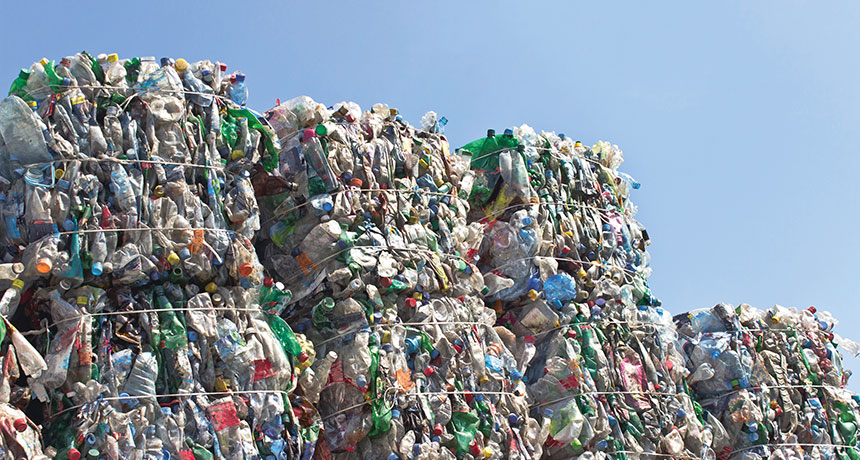This microbe thinks plastic is dinner
A newly discovered bacterium chows down on plastics — which could make it helpful in pollution cleanup

Researchers have learned that a newfound bacterium munches on a plastic, known as PET. That plastic is used in making plastic bottles like these, that often end up polluting the environment.
gavran333/istockphoto
Researchers have found a microbe that chows down on a major polluting plastic.
People value this plastic because it can be made into stiff and strong fibers. This plastic also can be molded into semi-hard sheets. Because the material’s name is such a mouthful, most people just refer to it as PET — for polyethylene terephthalate (Pahl-ee-ETH-eh-leen TEHR-eh-THAAL-ayt). It is the basis of polyester fabrics and disposable beverage bottles. But the bacterium Ideonella sakaiensis doesn’t wear clothes or sip from bottles. For this microbe, PET is simply dinner.
Researchers in Japan discovered the germ in samples of soil, wastewater and the sludge that accumulates at some recycling plants. Bits of PET tainted all of the samples. That’s not too surprising. This plastic is very stable, and few known microbes can break it down. But I. sakaiensis can use PET as its main food source, the new data show.
Shosuke Yoshida works at Kyoto University in Japan. His team shared its new data on the PET-eating microbe in the March 11 Science.
Tests show that these microbes first latch onto the plastic. Then they release a protein that breaks the plastic down into smaller molecules that the microbe can munch on.
Millions of tons of PET are made every year. Most microbes that degrade plastics have no interest in PET. That’s why the long-lasting plastic can build up in the environment, where it can pose a risk to wildlife. With its appetite for this pollutant, however, the newfound microbe might turn out to find a welcome role in plastic-waste cleanup, Yoshida’s team says.
Power Words
(for more about Power Words, click here)
bacterium (plural bacteria) A single-celled organism. These dwell nearly everywhere on Earth, from the bottom of the sea to inside animals.
germ Any one-celled microorganism, such as a bacterium, fungal species or virus particle. Some germs cause disease. Others can promote the health of higher-order organisms, including birds and mammals. The health effects of most germs, however, remain unknown.
microbe Short for microorganism. A living thing that is too small to see with the unaided eye, including bacteria, some fungi and many other organisms such as amoebas. Most consist of a single cell.
molecule An electrically neutral group of atoms that represents the smallest possible amount of a chemical compound. Molecules can be made of single types of atoms or of different types. For example, the oxygen in the air is made of two oxygen atoms (O2), but water is made of two hydrogen atoms and one oxygen atom (H2O).
plastic Any of a series of materials that are easily deformable; or synthetic materials that have been made from polymers (long strings of some building-block molecule) that tend to be lightweight, inexpensive and resistant to degradation.
polyester A synthetic material used chiefly to make fabrics.
polyethylene terephthalate A commonly used type of plastic, usually referred to simply as PET. It can be produced as strong, stable fibers for use in making clothing. It also is the basis of many plastic beverage bottles (such as milk jugs) and semi-hard food packages (often used for produce). When used in fabrics, it’s simply known as polyester. To identify these plastics in goods other than clothing, they tend to carry a labeled on the bottom or side with the number 1 surrounded by the triangular “chasing arrows” symbol and the acronym PET or PETE below the triangle.
proteins Compounds made from one or more long chains of amino acids. Proteins are an essential part of all living organisms. They form the basis of living cells, muscle and tissues; they also do the work inside of cells. The hemoglobin in blood and the antibodies that attempt to fight infections are among the better-known, stand-alone proteins.Medicines frequently work by latching onto proteins.
sludge A soft, viscous mix of water and mud or other solids. This muck can form naturally or as a result of filtering out the solids from water at sewage- or wastewater-treatment plants.
wastewater Any water that has been used for some purpose (such as cleaning) and no longer is clean or safe enough for use without some type of treatment. Examples include the water that goes down the kitchen sink or bathtub or water that has been used in manufacturing some product, such as a dyed fabric.







